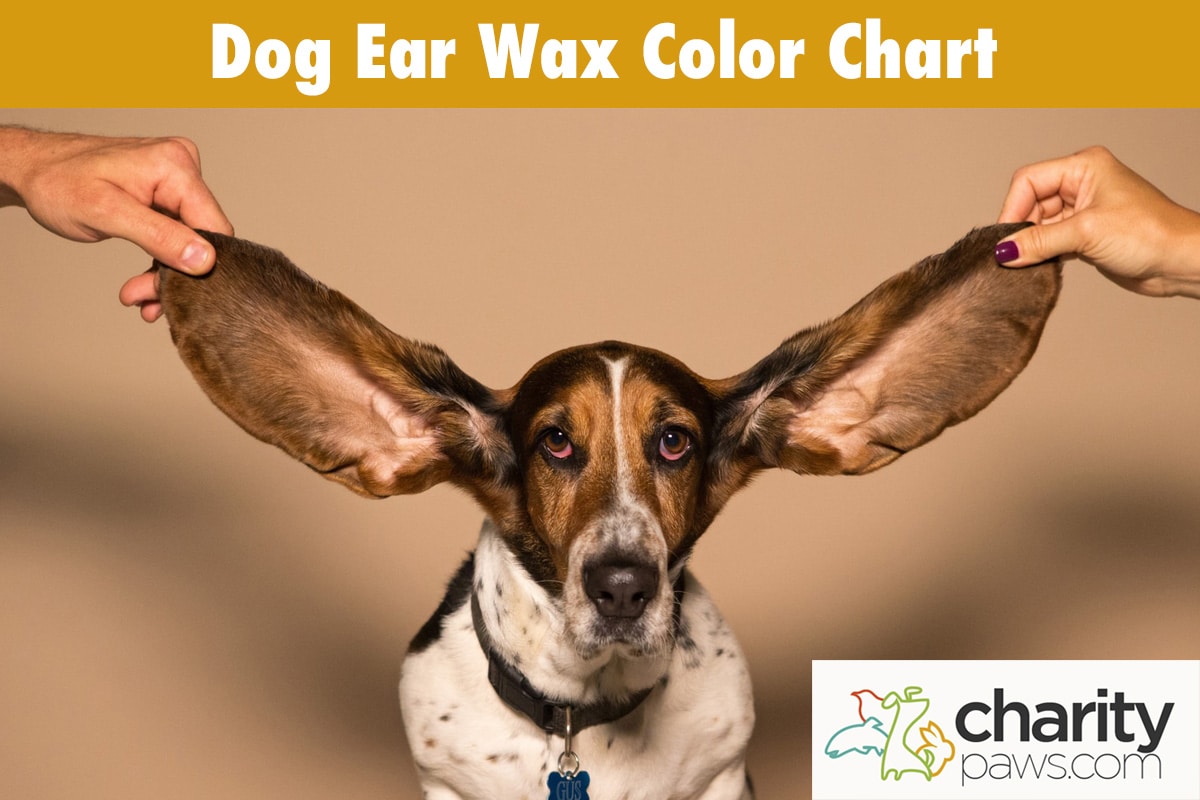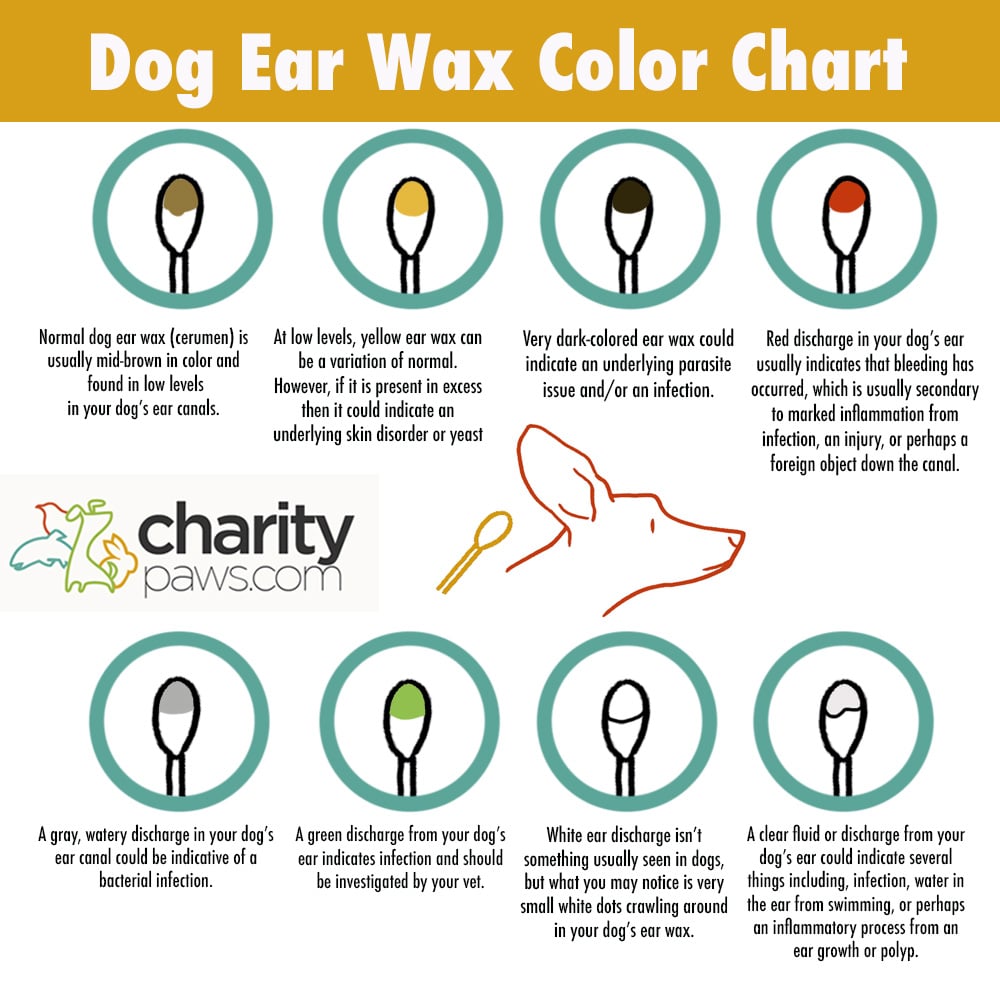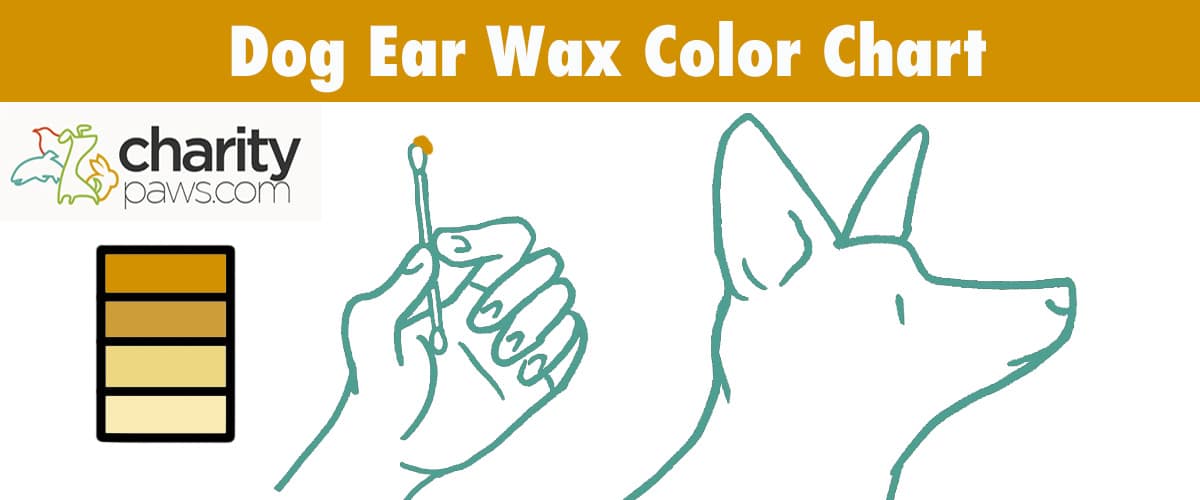Ear wax in dogs is not something that many owners give much thought to, but it’s very important to know what is normal and what is not.
Many dogs will have an ear infection at least once in their lifetime.
The sooner you can identify a problem the sooner you can get appropriate treatment from your veterinarian.
Sometimes the colors of dog ear wax may catch you by surprise, so knowing what the colors mean can help you know when treatment may be required.
Read on to find out more about what ear wax looks like in different situations as well as what you can do to help your dog.

What Is The Purpose Of Normal Ear Wax In Dogs?
The technical term for ear wax is cerumen, which is a normal finding at low levels in healthy dog ear canals.
Cerumen is secreted by glands in the ear canal and it helps to collect dust, dirt, and debris.
The cerumen and all these small unwanted particles, travel slowly back up the ear canal to be shed into the environment.
This process helps to keep your dog’s ear canals clean and in good health.
What Does Dog Ear Wax Look Like?
Normal dog ear wax (cerumen) is usually mid-brown in color and found in low levels in your dog’s ear canals.
Your dog’s ears should not smell particularly unpleasant, as normal ear wax doesn’t have a particularly strong odor.
Your dog’s ears and ear flaps (pinna) should be a healthy pale pink color, any signs of redness or irritation could indicate a problem.
Do I Need To Clean My Dog’s Ears?
If your dog has healthy ears, then there should not be a need to clean them.
In most dogs, their ears are self-cleaning and will maintain a healthy balance of ear wax.
Excessive cleaning of the ears could alter the natural pH of the skin inside the canals, actually predisposing your dog to ear infections.
If your dog’s ears appear normal then you can leave them alone.
There are, however, some situations where dogs would benefit from ear cleaning, but your vet will advise you if your dog could benefit from this.
Does The Color Of Earwax Indicate Health Issues?
The color of your dog’s ear wax could indicate health issues.
Normal ear wax is usually light to mid-brown in color.
If your dog’s ear wax is a color other than this then it could indicate a problem particularly if it smells bad, or your dog seems uncomfortable.
Shaking his head, scratching his ears, and rubbing his face could indicate he is not happy.
Colors Of Earwax In Dogs
Earwax color can stray away from its normal mid-brown appearance if there is an underlying problem going on.
Our color chart is here as a guide, but you must always see your vet for a definitive diagnosis if you are not happy with what you see.
Yellow Earwax
At low levels, yellow ear wax can be a variation of normal.
However, if it is present in excess then it could indicate an underlying skin disorder or yeast infection.
The ear wax can appear greasy and pale yellow in breeds that have issues with skin complaints like skin allergies or seborrhea.
This can lead to an overgrowth of a yeast called Malassezia.
This yeast is normally present in low levels on healthy dogs but can multiply out of control if your dog has underlying skin issues.
Black (or dark brown) Earwax
Very dark-colored ear wax could indicate an underlying parasite issue and/or an infection.
Ear mites (Otodectes cynotis) could cause wax that appears this color, but so could yeast or bacterial infections.
Red Earwax
Red discharge in your dog’s ear usually indicates that bleeding has occurred, which is usually secondary to marked inflammation from infection, an injury, or perhaps a foreign object down the canal.
Quite often the amount of bleeding is quite small, but it can become mixed with wax or discharge in your dog’s ear canal, giving a reddish tinge.
Blood is a sign that your dog has a very sore ear so make sure you get it checked out.
Gray Earwax
A gray, watery discharge in your dog’s ear canal could be indicative of a bacterial infection.
Pseudomonas aeruginosa is one type of bacteria that could cause nasty discharge in your dog’s ear.
This bacterium is sometimes tricky to treat as it can develop resistance to various antibiotics.
Culture and sensitivity is helpful when determining what treatment regime is most effective for your dog.
Green Earwax
A green discharge from your dog’s ear indicates infection and should be investigated by your vet.
A green discharge is often wet and mucous-like and may have a bad odor.
Your vet should recommend that samples are taken for further analysis, to determine what type of infection is present and what antibiotics are most effective.
White Earwax
White ear discharge isn’t something usually seen in dogs, but what you may notice is very small white dots crawling around in your dog’s ear wax.
These could be ear mites (Otodectes cynotis) which can make your dog’s ears itchy and uncomfortable.
Clear Earwax
A clear fluid or discharge from your dog’s ear could indicate several things including, infection, water in the ear from swimming, or perhaps an inflammatory process from an ear growth or polyp.

What Are The Signs Of Ear Infections In Dogs?
As well as seeing a different color wax or discharge from your dog’s ear you may see the following signs if your dog has an ear infection:
- A bad odor from one or both ears
- An increase in the amount of ear wax normally seen
- Increased scratching, head shaking, or rubbing at his ears
- Inflammation of the ear canals
- Red or inflamed ear flaps (pinnae)
- A swollen ear flap (pinna) indicating an aural hematoma
- His ear sounds moist or ‘squelchy’ when you give it a rub
- He cries or whines in pain when his ear is touched
How Are Ear Infections In Dogs Treated?
Initial examination
If you suspect there is an issue with your dog’s ear then take him to your vet for a check up.
They will start by examining your dog.
Using an otoscope, they will look down your dog’s ear canals to assess the amount of discharge present and look for any abnormalities.
Your vet will be able to see how inflamed your dog’s ear canals are, look for any masses or growths, and check for foreign bodies like grass seeds.
The next steps will depend on their initial findings.
Sometimes an anesthetic is required
If your dog’s ears are too painful for examination, they will usually need anesthetizing for a more thorough check.
This may also mean your dog has an ear flush at the same time to remove excess wax and discharge, allowing for a better exam.
Your vet will usually try and see your dog’s tympanic membrane (eardrum) as in some infections this can become ruptured.
If your dog has a foreign body like a grass seed, then this will often be easier to remove under anesthetic too.
Samples can be useful
Samples of your dog’s ear wax can be quite helpful to plan appropriate treatment.
These samples can be looked at under a microscope to screen for parasites like ear mites and look for the growth of yeast or bacteria.
Swabs of your dog’s ear wax may also be sent to a lab for something called culture and sensitivity.
The lab will grow microorganisms from your dog’s ear discharge on a nutrient-rich plate and determine not only what type of microbe it is, but also what antibiotics or antifungals might be effective against it.
Some bacteria can be resistant to commonly used antibiotics, so understanding what works will mean your vet will be able to prescribe more effective medications.
Sometimes other tests are advised to rule out underlying conditions that may have predisposed your dog to an ear problem in the first place such as, skin allergies or hypothyroidism.
A treatment plan is made
Using the findings from their examination and any laboratory work, your vet will make a treatment plan for your dog.
Most ear infections are best treated with a combination of ear cleaners and medicated ear drops.
The cleaner will shift excess wax and discharge out of the way, allowing the medicated drops to do their job.
Ear drops will often contain a combination of an antibiotic, an antifungal, and/or an anti-inflammatory, which will help reduce itchiness and make your dog more comfortable.
Your vet will advise you further on the exact treatment type of topical treatment your dog requires and how often you need to administer it.
Always follow their instructions carefully.
Other treatments that can be helpful for dogs with ear infections may include:
- Anti-parasite products to treat eat mite infestations.
- Anti-inflammatory tablets or injections such as steroids, to reduce itchiness, redness and make your dog more comfortable, which can be helpful when trying to administer drops down a sore ear.
- Other allergy medications, like antihistamines or other drugs aimed at reducing your dog’s immune response to allergens.
- A change in diet to a novel protein or hypoallergenic alternative may be advised if underlying food allergies are suspected as a trigger for your dog’s ear problems.
- Surgery is sometimes indicated if there are masses or polyps present in your dog’s ear canal. Some dogs with chronic infections, leading to an extremely diseased ear canal may even benefit from total ear canal ablation (TECA) surgery.
Conclusion On Dog Ear Wax Color

Remember that our dog ear wax color chart is a guide only, and if you see anything unusual in your dog’s ear then you should seek help from your vet for a proper diagnosis.
Many ear infections can be straightforward to treat if they are dealt with promptly, so don’t ignore things.
Speak to your vet today if your dog’s ears are not their normal, healthy appearance.
FAQs
What is this brown stuff in my dog’s ear?
If you are seeing a lot of brown gunk or wax in your dog’s ear canals this could indicate an issue.
Infection, ear mites, a foreign body, or even a mass or polyp in your dog’s ear canal could lead to an excessive amount of ear wax.
Don’t forget that small amounts of brown ear wax can be normal, especially if there is no evidence of malodor or inflammation.
How to tell if it’s ear wax or something else?
All dogs will have a small amount of ear wax (cerumen) which helps to keep the ear canal healthy and free from dirt and debris.
If you are seeing an increased and more noticeable amount of wax or your dog is excessively itchy, this could indicate a problem like ear mites or an infection.
Some dogs will also have smelly ears, which may be red and uncomfortable, always see your vet if you suspect a problem.
How can I treat my dog’s ear infection at home?
The simple answer is, don’t!
Some of the most serious ear infections seen in clinics are from dog owners that have wasted time and money with home remedies or unlicensed products bought online.
Instead, you should see your vet promptly to nip any problems in the bud quickly and effectively.

